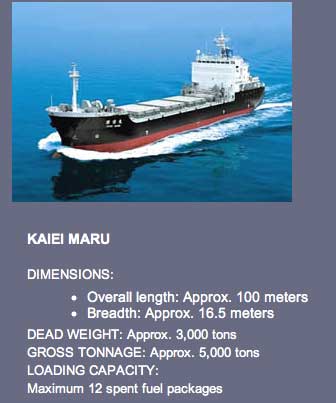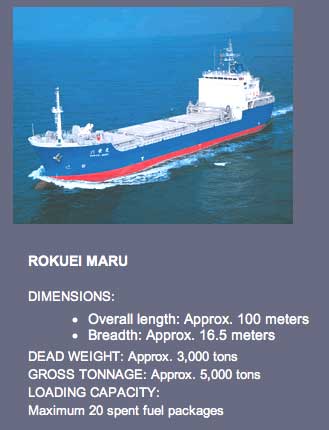
I transport by bike almost all the garden supplies for my balcony garden, including plants and soil. The big box, home center is about 2 kilometers away.

I transport by bike almost all the garden supplies for my balcony garden, including plants and soil. The big box, home center is about 2 kilometers away.

Tokyo’s great transit system allows you to go many places without a car. You can enjoy the scenery and meeting many people.
電車がたくさんあるので、車なしでいろいろな所へ行けます。多くの人に会えるし、きれいな景色を楽しめます。
The days are getting shorter, and with clearer skies the sunsets are remarkable. Recently I have been enjoying the views from elevated trains and stations. Trains in Japan are always punctual, clean and efficient. And apart from peak commute times, you can relax and enjoy the peacefulness of leaving the driving to others. Tokyo’s superior urban transportation system allows for a city where private cars are not the main form of mobility. It is still surprising to me how much walking, biking, conversation, playing, and reading dominates Tokyo’s many small streets, with the occasional car slowing down to pedestrians’ pace.

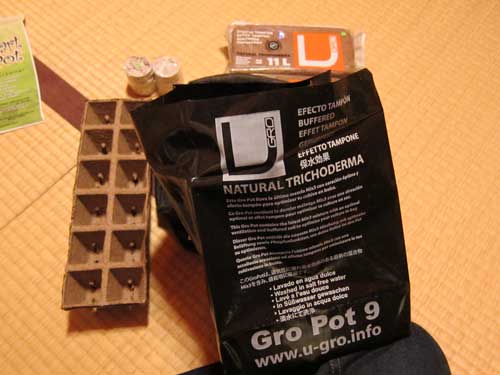
For urban gardeners, one key question is how to get plants, soil and pot from store to house. I buy many of my plants from small shops that are on my way from the train station to my apartment. Sometimes I bike to a DIY big box store called Shimatchu, and use a combination of large backpack and balancing plants in plastic bags across my handle bars.
Recently I discovered coconut husk as a soil. It’s sold at a wonderful Kichijoji indoor growing shop called Essence. Made entirely of husk, it recycles what would otherwise be waste, and it seems to be a high quality organic soil. Even better, it is sold dehydrated, so it is very light weight for transportation from shop to home.

I have bought three blocks (also called tampons) that make 11 liters when hydrated. Nakata-san of Essence recommended blending it 3-1-1 with perlite and vermiculite, which are also very light weight and low cost. When blended it makes about two regular sized buckets of soil.
I also used coco husk soil in small disks that expand with water to form seedling starters wrapped in a simple rope pouch.

You can see that my morning glory seeds were the first to sprout.
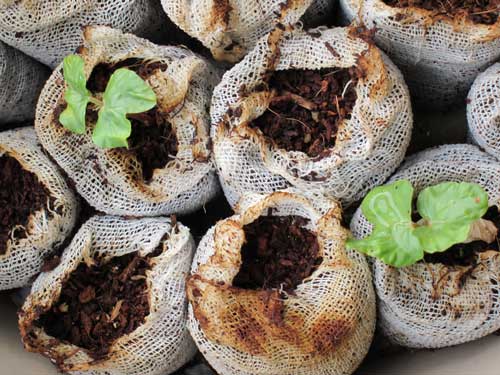
I also bought this funny Gro-Pot, a thick plastic bag with coco husk that you hydrate and plant directly into, as if it were a flower pot. I’ve put a sunflower in my Gro-Pot (bought for 500 yen, just over $5 from a local flower shop). Both the Gro-Pot and the coconut husk block are from U-Gro.

For the coco husk mix, I used another light weight new idea: Smartpots, a soft-side fabric container that claims to be better than plastic and clay containers, is super easy to carry and store. The makers claim that these polypropylene containers aerate and air prune the roots. When you buy the smartpots, they come folded up, which is very convenient.

Recently I heard Mishima Yoshiki present a paper about the revival of the Kyobashi river in central Tokyo. Like most of Tokyo’s legendary rivers and canals, it has long been buried underground, when the Edo tradition of water transportation gave way to twentieth century freeways for private autos and commercial trucks.

Mishima’s paper was presented at the Tokyo University’s Asia Mega-Cities symposium in a session devoted to urban rivers. His paper was co-authored with Hayashi Masaki, Shikanai Kyoko, and Ishikawa Mikiko. Mishima is a PhD candidate at Todai’s graduate school of engineering, and a landscape architect trained at the Harvard Graduate School of Design.
Many landscape architects and urban historians point to the centrality of water in Tokyo’s history, and there is a growing desire to see its renewal in our post-industrial era. Mishima’s talk highlighted the Edo functions of the Kyobashi river, the history of its “reclamation” or burial, and the opportunities to remake it today.

Mishima’s project team chose the Kyobashi river because it is in central Tokyo and it is relatively short, with a history of connecting the Edo castle to the ocean. The paper introduced the concept of the kashi, a riverside commons that served as a place for unloading goods and commercial markets and where no private structures were allowed to be created. Today it has exceptional potential because it represents a mere 600 meters of the 320 kilometer Tokyo Expressway system, and is used by only 4,000 of the 53,000 daily expressway vehicles. Plus, its central location offers enormous potential as public open space and high rent commercial space.

Mishima explained how the Kyobashi river, like most of Tokyo’s waterways, became devalued and ultimately buried in the twentieth century when natural and human disasters overwhelmed the city. The 1923 Kanto Earthquake destroyed the kashi, and many private buildings were constructed. River commerce had already declined, and increasing garbage raised sanitation problems. The firebombing of Tokyo during World War II left huge piles of ashes along the river banks, making open space again a place for waste.

The post-war period saw some bizarrely futuristic plans. The 1950 “Sky Building Plan” envisioned building twelve story buildings above the old river, with an expressway running through the second floor. I am curious why this plan was ultimately rejected. In its stead, the city built a series of elevated freeways, mostly public and some privately owned, with several including the Kyobashi river having commercial tenants on the ground floor.
I enjoyed seeing the model of the renewal of the Kyobashi river. Using rainwater, treated sewage, and springs, there were would be plenty of water to support the new river. Water is constantly being pumped out from the subway tunnels (this happens in New York City as well, which I learned in the fantastic book The World without Us by Alan Weisman).
The Kyobashi river concept combines commercial development with the creation of a huge new green corridor. Some buildings would be placed on the new river, as a way to generate revenue for the construction and maintenance of the new public spaces. Green roofs would integrate the new buildings with the park. People would have access to the river on bridges, plazas, water decks, and recreational boats. It would be great to also see a river edge that combined some elements of natural riverbank vegetation and habitat.
Several factors make the idea of this project at least conceivable. One, the Kyobashi river area is small and borders high rent Ginza. Second, the elevated freeway, like most of Tokyo’s expressways, was built in the rush to “modernize” before the 1964 Tokyo Olympics. Therefore, they do not meet current earthquake standards, and the city currently faces a choice between expensive retrofitting or potential collapse. (The earthquake damage to San Francisco’s Embarcadero freeway in 1989 provided the impetus for freeway removal and opening the bay to the city in the early 2000s, which has been a huge success). Lastly, the low rent payed by the private company suggests that the Tokyo Metropolitan Government and its residents receive minimal compensation in exchange for the environmental costs of the freeway.

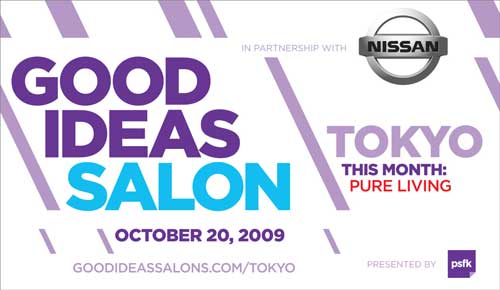
New York’s PSFK is organizing an “ideas salon,” sponsored by Nissan, about “pure living” and how it is manifested in design, technology, urban living and transportation. It’s tomorrow evening at Claska in Meguro, and unfortunately sold out.
Speakers include Peter Rojas – Technology Guru, Founder at gdgt, Engadget and Gizmodo, Marc Alt – Green Visionary, Founder at Marc Alt + Partners, Mark Dytham – Creative Catalyst, Partner at Klein Dytham architecture, and Founder of Pecha Kucha, Rie Azuma – Lifestyle Architect, Azuma Architecture, Danny Choo – Japan Sub-Culture Authority, Mirai Inc., dannychoo.com, Hiromi Matsubara – Green Media Activist, Co-founder, Greenz.jp, and Piers Fawkes – Trends Expert, Founder at PSFK (moderator).
(Disclosure: Piers treated me to a lovely breakfast this morning in Shibuya).

Tokyo Green Space examines the ecological and human benefit of reimagining cities with a focus on people and natural environments. I was interested to read a provocative article recently in Business Week entitles: “Cities: A Smart Alternative to Cars.”
The author Alex Steffen of Worldchanging argues that rebuilding cities into walkable places through in-fill and zoning changes might be more realistic and faster than the typical 16 year cycle to replace 90% of the United States automobile fleet. His definition of a new urban city is one in which daily driving is not a necessity and many people can live without private car ownership.
It is interesting that confronted with climate change, some hope that technological change will allow Americans to live as we have for the past thirty years with no change: zero emissions vehicles allowing for the same transportation patterns, and new building materials to permit the same massive housing structures. It’s analogous to finding a pharmaceutical cure for the effects of obesity without changing the foods we eat or the energy we exert.
The costs are staggering: transportation accounts for 25% of United States carbon, and 20% of that from personal transportation. There is also the environmental burden of manufacturing and disposal. I was surprised to learn that Americans spend more than 19% of household income on personal transportation, second only to housing.
Perhaps hardest for Americans to grasp is that denser, walkable cities can improve lifestyle compared to McMansions and suburbs. Well design buildings, smart infrastructure, and the community created through walking and biking could be a huge improvement to quality of life. Tokyo certainly exhibits many of the advantages of compact, transit-oriented cities where almost all daily activities are accessed by foot, transit and bike.
In addition to environmental and economic benefits, compact cities create more human interaction and community, improved public health from daily walking, and an opportunity to use public space currently devoted to vehicles for urban plants and wildlife.
(Note: I found this article on Allison Arieff twitter feed: http://twitter.com/aarieff)
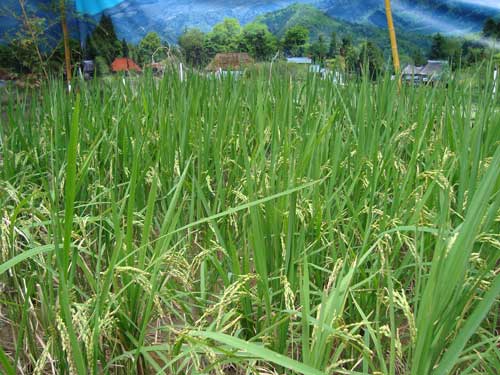
On the first day of October, I visited Ginza Farm, and saw the rice is almost ready to be harvested. San Francisco Chronicle’s transportation reporter asked to interview me about Tokyo Green Space, and I thought there was no better public place to meet than Ginza Farm. The reporter’s interpreter told us that one sign that the rice is close to being ready is that the stalks start to droop under the weight of the grains.

According to the United Nations Population Fund, in 2008 the world achieved an urbanization milestone, 3.3 billion people, more than half the world’s peoples, now lived in cities.
By 2030, 5 billion people will be city dwellers, and more than 81% will be in developing countries. From 2000 to 2030, in one generation the urban populations of Asia and Africa will double (from 1.7 to 3.4 billion).
The pace of urbanization is astonishing. From 1900 to 2000, the number of city dwellers rose from 220 million to 2.8 billion, an increase of more than 10 times. Poverty and sustainability are the two biggest challenges of our century’s global urbanization, with implications for transportation, water and energy supplies.
The role of gardeners in retrofitting mature cities and building emerging cities is vital in promoting cities where residents are connecting to each other and the environment. I hope that Tokyo Green Space can contribute ideas for global urbanization and development.
Related posts: Peter Head’s “Entering the Ecological Age”
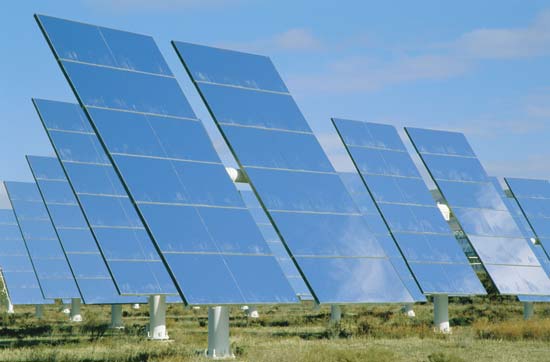
As I wrote earlier, the Democratic Party of Japan, which recently won a landslide election, is calling for major environmental changes, including significantly greater carbon emission targets than the outgoing LDP party. This week I learned that, on the premise of reviving the struggling Japanese countryside, the DPJ has also promised to reduce the gasoline tax and highway tolls. These pro-automobile ideas will not help with emissions targets.
Keidanren, the Japan Business Federation, is strongly opposed to the more ambitious emission goals. By calculating the difference in today’s prices between fossil fuels and renewable energy, numbers have been created to alarm the public about costs to consumers and businesses. A particularly Japanese explanation I heard from one Japanese corporate spokesperson was articulated as concern for the finances of business customers.
This organized resistance to change strikes me as short-sighted. According to a Japan Ministry of Foreign Affairs chart based on International Energy Agency data, Japan is already the world’s most energy efficient nation (calculated as energy supply per unit of GDP): three times more efficient than the global rate, twice as efficient as the US, almost twice more than the European Union, and more than seven times India and China.
In the United States, Obama has called for 25% of electric energy to come from renewable sources by 2025. The DPJ’s solar subsidies and carbon taxes will spur adoption of solar energy, benefiting Sharp and Kyocera. In a world of climate change and peak oil, investing now in renewable energy seems vital for Japan’s energy security and global technology exports.
If the focus is strictly on carbon emissions, and not renewable energy, Japan risks further dependence on nuclear energy. Already 26% of electric power in 2007, nuclear power produces dangerous waste, all the more so in a small island nation prone to earthquakes. This makes news that nuclear industry and international energy leaders are seeking to increase operating rates. From the Japan Times,
Nobuo Tanaka, executive director of the International Energy Agency, urged Japan last year to relax its “hyper cautious” atomic safety standards to increase output.
The country’s operating rate averaged 59 percent in 2008, compared with 90 percent in the U.S. and 76 percent in France, according to industry group the Japan Atomic Industrial Forum Inc.
With energy use increasing in the developing world, now is the time to debate the difference between carbon neutral and renewable energy, and the role of national governments in promoting change that can spur international competitive economic advantage.
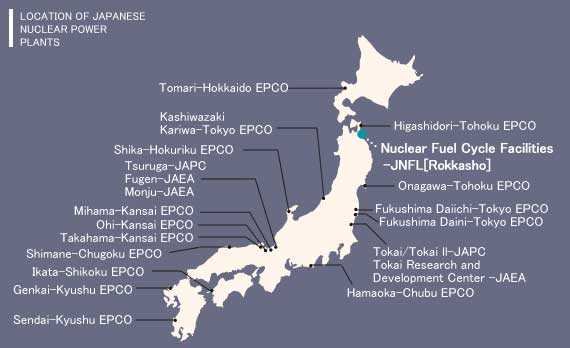
(from the Nuclear Fuel Transport Co, Ltd)
